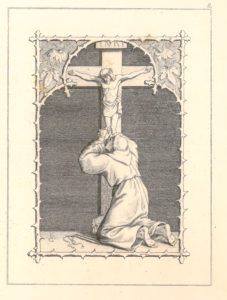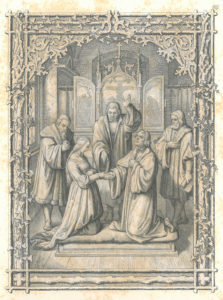by Rev. Jonathon T. Krenz
 Marriage is under attack on many fronts. The issues include no-fault divorce, pre-marital/extra-marital sex, living together outside of marriage, same-sex “marriage,” not to mention all of the gender confusion infiltrating nearly every facet of our society. The culture itself has been hyper-sexualized, obsessed with sexuality in television and movies, music, literature, and even in education. Our children are exposed to internet pornography at younger and younger ages. Then there is the religious freedom debate and the question of conscience. Do Christian bakers have to bake cakes for same-sex weddings? What about Christian photographers or florists? Are they obligated to participate in same-sex weddings? Can wedding venues refuse services to same-sex couples? Can churches? Pastors? Underlying all of this is the question, “What is marriage?” And the answer depends on whether marriage belongs to God or to man. The Church maintains the biblical teaching that marriage is from God. He defines it and gives it meaning. The culture increasingly maintains that marriage is man’s institution. Thus marriage can be defined according to the shifting winds of popular opinion, and ultimately government mandate. This is to rob marriage of any real objective meaning.
Marriage is under attack on many fronts. The issues include no-fault divorce, pre-marital/extra-marital sex, living together outside of marriage, same-sex “marriage,” not to mention all of the gender confusion infiltrating nearly every facet of our society. The culture itself has been hyper-sexualized, obsessed with sexuality in television and movies, music, literature, and even in education. Our children are exposed to internet pornography at younger and younger ages. Then there is the religious freedom debate and the question of conscience. Do Christian bakers have to bake cakes for same-sex weddings? What about Christian photographers or florists? Are they obligated to participate in same-sex weddings? Can wedding venues refuse services to same-sex couples? Can churches? Pastors? Underlying all of this is the question, “What is marriage?” And the answer depends on whether marriage belongs to God or to man. The Church maintains the biblical teaching that marriage is from God. He defines it and gives it meaning. The culture increasingly maintains that marriage is man’s institution. Thus marriage can be defined according to the shifting winds of popular opinion, and ultimately government mandate. This is to rob marriage of any real objective meaning.
 Luther had a similar problem in mind when he wrote his Marriage Booklet in 1529. Celibate life in a monastery was considered holier than wedlock. Marriage was earthly, monasticism heavenly. To be sure, Rome considered (and still considers) marriage a sacrament. But holy orders (joining a monastery or convent) was a better, more meritorious sacrament. And so a man-made institution, the monastic order, was substituted for a God-given institution, holy matrimony. Ironically, while Luther and his heirs do not consider marriage a sacrament, as God’s institution and gift, we confess it to be a high and holy calling.
Luther had a similar problem in mind when he wrote his Marriage Booklet in 1529. Celibate life in a monastery was considered holier than wedlock. Marriage was earthly, monasticism heavenly. To be sure, Rome considered (and still considers) marriage a sacrament. But holy orders (joining a monastery or convent) was a better, more meritorious sacrament. And so a man-made institution, the monastic order, was substituted for a God-given institution, holy matrimony. Ironically, while Luther and his heirs do not consider marriage a sacrament, as God’s institution and gift, we confess it to be a high and holy calling.
In light of these assaults on marriage, past and present, Luther’s Marriage Booklet[1] offers timely medicine. Originally published as a separate booklet in 1529, the Marriage Booklet was appended to most editions of the Small Catechism during Luther’s lifetime.[2] The concern was to give pastors a marriage rite that would fit with local customs while maintaining the inherent dignity and holiness of marriage as God’s institution and the heart of civil society. Marriage, as it is given for the companionship of man and woman, for the enjoyment of God’s gift of sexuality, and for procreation,[3] should be upheld in reverence and with proper decorum. “Because up to now people have made such a big display at the consecration of monks and nuns (even though their estate and existence is an ungodly, human invention without any basis in the Bible), how much more should we honor this godly estate of marriage and bless it, pray for it, and adorn it in an even more glorious manner… it has God’s Word on its side and is not a human invention or institution.”[4]
For Luther, there are two aspects of the Christian marriage rite: The civil contract and the blessing of the marriage by God’s Word and prayer. The civil responsibility of the pastor begins with the publication of the banns from the pulpit prior to the wedding ceremony.[5] This gives anyone who objects to the union an opportunity to be heard. The civil ceremony itself takes place at the door of the Church. This is where the vows and rings are exchanged in front of God and congregation as witnesses, and the man and woman are declared to be husband and wife. Here the pastor is a representative of the civil authority, presiding over a legal contract. The promise is binding. “What God joins together, no human being ought to separate.”[6]

At this point, the Christian couple, already married, proceeds to the altar for the blessing of their marriage. This is the actual Church service. First, the words instituting marriage are read from Genesis 2:18, 21-24. Marriage is given by God. What God gives is holy. Marriage is His gift to man, and it belongs to Him. He defines it and gives it meaning. “It is not good that the man should be alone” (Gen. 2:18; ESV). “And the rib that the LORD God had taken from the man he made into a woman and brought her to the man” (v. 22). Just as God gave marriage to Adam and Eve, so now He bestows it on this couple.
Ephesians 5:25-29 and 22-24 are then read, emphasizing God’s commandment to husband and wife and their responsibility toward one another. The husband is to love his wife as Christ, our Bridegroom, loves the Church and gave Himself up for her to make her holy. The wife is to be subject to her husband as to the Lord, even as the Church is subject to Christ as her divine Head. In this way, Christian husbands and wives serve as the living picture of Christ and His holy Bride, the Church. Their very marriage is a confession of faith to the world.
But this is a fallen world, and husband and wife are fallen people. Marriage is not to be entered into lightly, but in reverence and with eyes wide open. There is a cross to be borne in marriage, and so Genesis 3:16-19 is read. There will be pain and distress in childbearing and rearing, and there will be conflict between the sexes. The wife will “cringe” before her husband, and he will lord it over her. In providing for his wife and family, the husband will have to contend with thorns and thistles and put bread on the table by the sweat of his brow. Life will be hard. And in the end, husband and wife will die. This marriage will end with one spouse burying the other… “till death us do part.”[7]
 But there is also a promise and comfort. Genesis 1:27-28, 31 is read. God created man in His own image. He created male and female and gave His blessing: “Be fruitful and multiply and fill the earth and subdue it” (v. 28). God is pleased with marriage and He blesses it in His Word. By means of marriage He fills and rules over the earth. This is God’s design. Husband and wife have a high and holy calling. “Therefore Solomon also says, ‘Whoever finds a wife finds a good thing and obtains a blessing from the Lord.’”[8]
But there is also a promise and comfort. Genesis 1:27-28, 31 is read. God created man in His own image. He created male and female and gave His blessing: “Be fruitful and multiply and fill the earth and subdue it” (v. 28). God is pleased with marriage and He blesses it in His Word. By means of marriage He fills and rules over the earth. This is God’s design. Husband and wife have a high and holy calling. “Therefore Solomon also says, ‘Whoever finds a wife finds a good thing and obtains a blessing from the Lord.’”[8]
Finally, pastor and congregation commend the couple and their marriage to God in prayer. They pray for the preservation of marriage as God’s institution. “We beseech your never-ending goodness that you would not permit this your creation, ordinance, and blessing to be removed or destroyed, but graciously preserve it among us through Jesus Christ our Lord.”[9] There is recognition here that God preserves marriage as an institution by preserving concrete Christian marriages.
Marriage belongs to God and is His gift to man. In a context where marriage as God’s institution is under assault, Christians do well to study Luther’s words, which are really the Word of God from Holy Scripture. God grant us to repent of our own abuse of marriage and sexuality, our casual acceptance of cultural mores, and our flippancy toward this sacred institution. God grant us also by His grace to live in the forgiveness of sins in Christ, and believe His promises concerning the blessed estate of matrimony. God is pleased with it, and by it He fills and rules the earth. We should honor and revere marriage as God’s holy will, promote it to our children, pray for its sanctity, and model its holiness in our own relationships. To this end, God help us.
The Rev. Jonathon T. Krenz is pastor of Messiah Lutheran + Moscow Mission in Moscow, Idaho.
[1] In this article, I will use “A Marriage Booklet for Simple Pastors” as it appears in the Kolb/Wengert edition of The Book of Concord: The Confessions of the Evangelical Lutheran Church (Minneapolis: Fortress, 2000), pp. 367-71. Cf. “The Order of Marriage for Common Pastors,” LW 53:110-15.
[2] Footnote 126 in Kolb/Wengert, p. 367
[3] “Holy Matrimony,” Lutheran Service Book (St. Louis: Concordia, 2006), p. 275.
[4] Kolb/Wengert, p. 368.
[5] Even prior to the banns, the couple would announce their intention to marry in a public betrothal, complete with the consent of their parents (Editor’s introduction to “The Order of Marriage for Common Pastors,” LW 53:111).
[6] Kolb/Wengert, p. 369, citing Matt. 19:6.
[7] Lutheran Service Book, p. 276.
[8] Kolb/Wengert, p. 371. Luther is paraphrasing Proverbs 18:22.
[9] Ibid.
